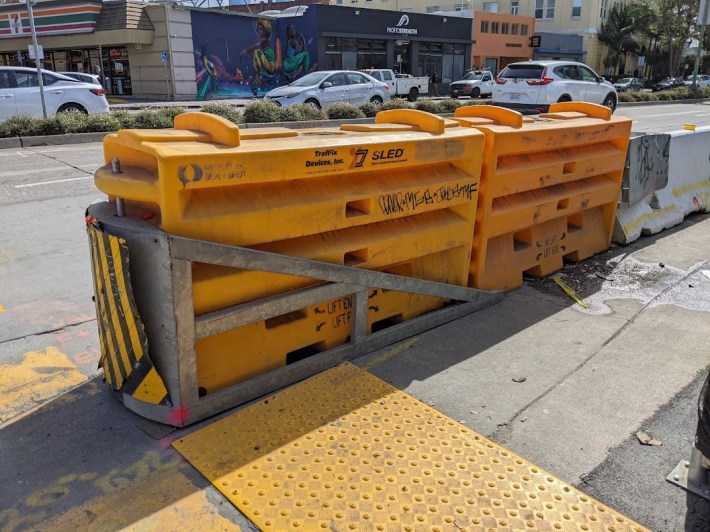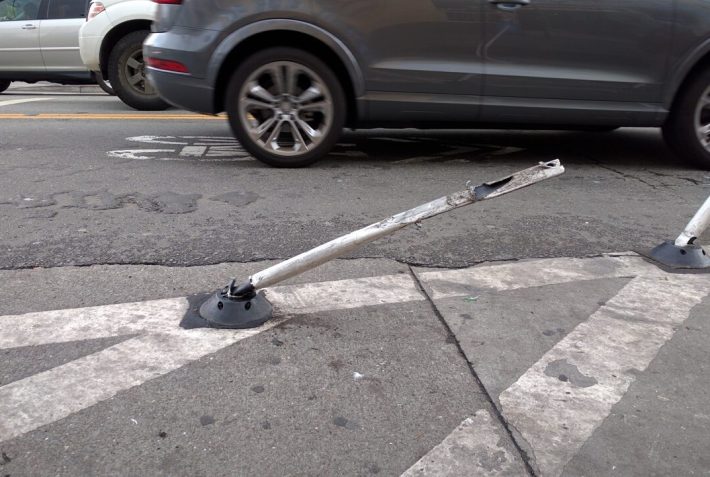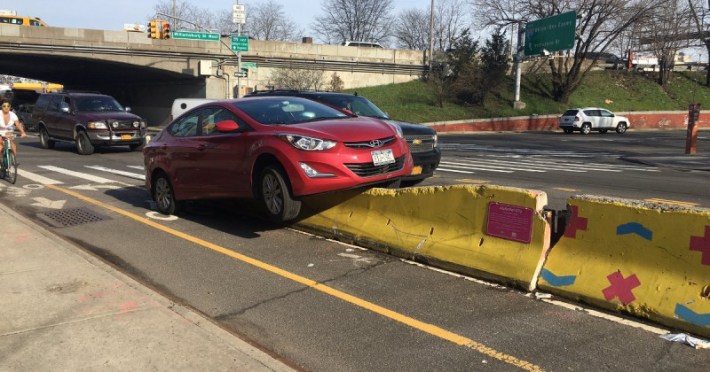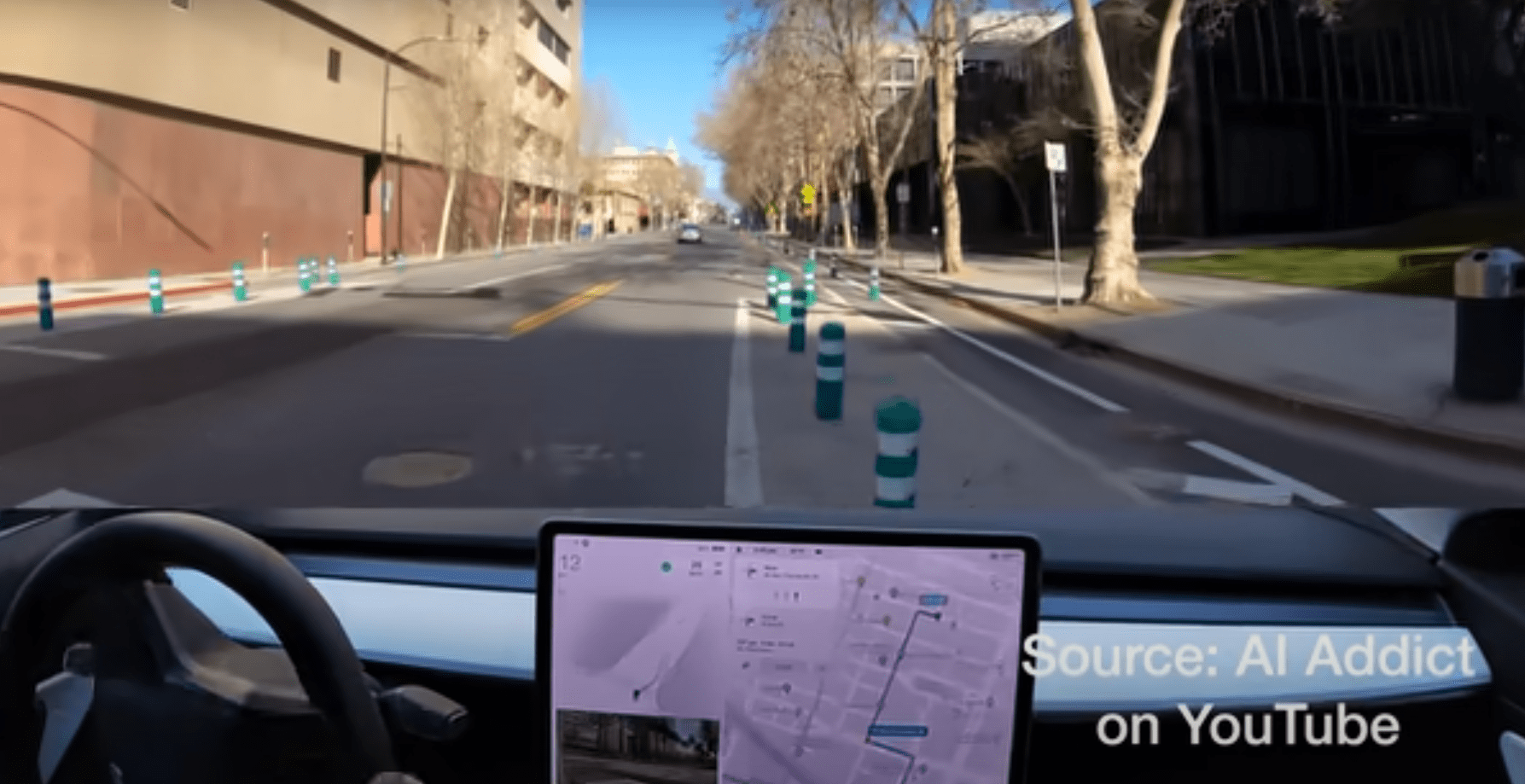Tesla fired an employee after he posted a video of an autonomous car driving erratically and running down plastic bollards that are part of a bicycle safety project in San Jose (the lead image is from the video). The story was reported on CNBC and other outlets.
This isn't the first time someone has posted a video of a Tesla autonomous vehicle endangering cyclists. Here's a Tweet from the Marin County Bicycle Coalition's Warren Wells that features a Tesla swerving at a cyclist in a way that almost seems intentional. The backup driver's quick reflexes narrowly averted tragedy.
While they're talking about *how safe Teslas are*, the driver wrenches the wheel from the FSD to avoid hitting a cyclist.
— Warren J. Wells, AICP 🚴🏙️🦀 (@WarrenJWells) February 9, 2022
Nervous laughter ensues.
So-called "autonomous vehicles" are not ready for our streets.https://t.co/alhFJZnG3G
Seconds before the computer-driver nearly kills the cyclist, the passenger remarks that a simple software upgrade can make thousands of people drive safer.
It follows that a buggy software upgrade could end thousands of lives.
This brings up the real issue when it comes to safety: cars are designed with crumple zones, airbags, seatbelts, and a host of other safety features to protect occupants. Roads are designed to minimize damage to cars and injuries to vehicle occupants. Take, for instance, this "sled" energy absorption device in front of this stretch of k-rail in Oakland:

The picture above is typical. Engineers place sleds at the start of sections of concrete barriers. In this case, the barrier is protecting pedestrians and workers at a construction site. The sled is filled with water to adsorb energy and keep errant drivers who are too busy texting, speeding, drinking, letting a Tesla Autopilot drive, or otherwise behaving irresponsibly from killing themselves on the protective concrete.
And yet, cyclists are forced to ride between this concrete barrier and moving cars. What do they get for protection? In this case just a painted stripe. Sometimes they get some plastic posts to remind drivers, if they happen to be paying attention or are properly-coded, not to slaughter them.
Everyone has seen videos of crash dummies in cars and how modern safety measures help keep them safe. Below is something most people have probably never seen: one of those crash dummies on a bike getting hit by a vehicle, part of a testing program from the Department of Mechanical and Aerospace Engineering at Carleton University in Ottawa, Canada:
So drivers and vehicle occupants get layers of physical protection in the car's design and built into the road. But most American traffic engineers are so irresponsible that they try to pass this off as protection for cyclists:

For contrast, here's what it looks like when a deadly collision between a cyclist and a motorist is prevented by a properly protected bike lane:

That's from New York City, where responsible planners and engineers have now vowed to start using concrete to protect cyclists.
And this is what it looks like when pedestrians are protected by responsible planners and engineers in London:
Anyone book an Uber?#WorldBollardAssociation
— World Bollard Association™ (@WorldBollard) March 11, 2022
@VeloDharma pic.twitter.com/Ys7d48iH1L
Is this starting to make sense now, traffic engineers, policymakers, and idiots who still think autonomous vehicles are going to make roads safe for everyone?
Stop building unprotected bike lanes. And stop building bike lanes with plastic posts. Use concrete, steel, water-filled barrels, Jersey barrier, planters, etc. Apply the same standards even to temporary installations. In other words, start showing some base-level responsibility when it comes to the lives of people not in cars.
And when Tesla, Waymo, etc., complain that their test cars are wrecking on the new obstacles--well, maybe they shouldn't be running dangerous experiments on city streets, using random cyclists and pedestrians as guinea pigs





